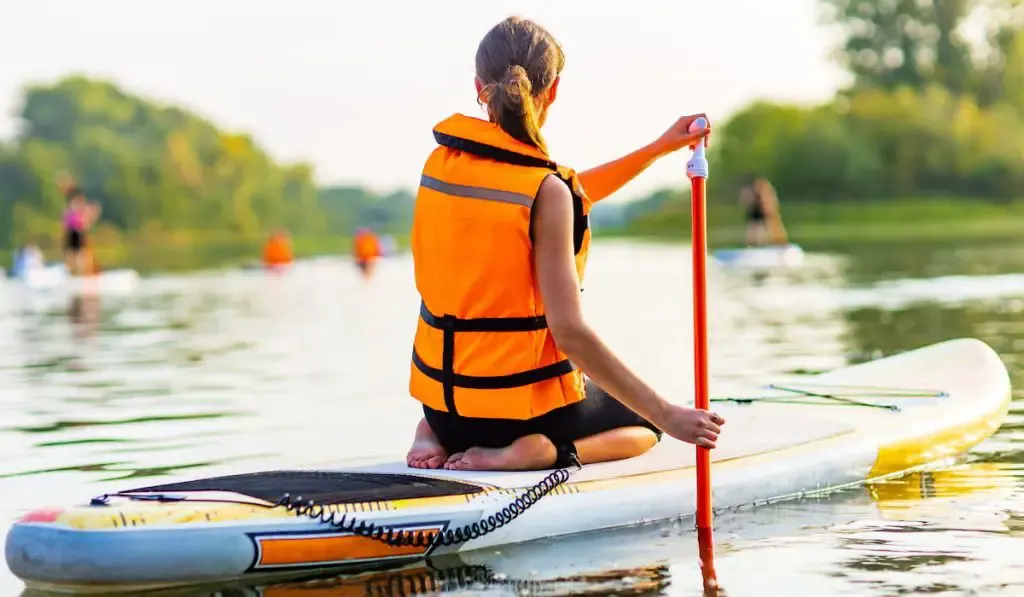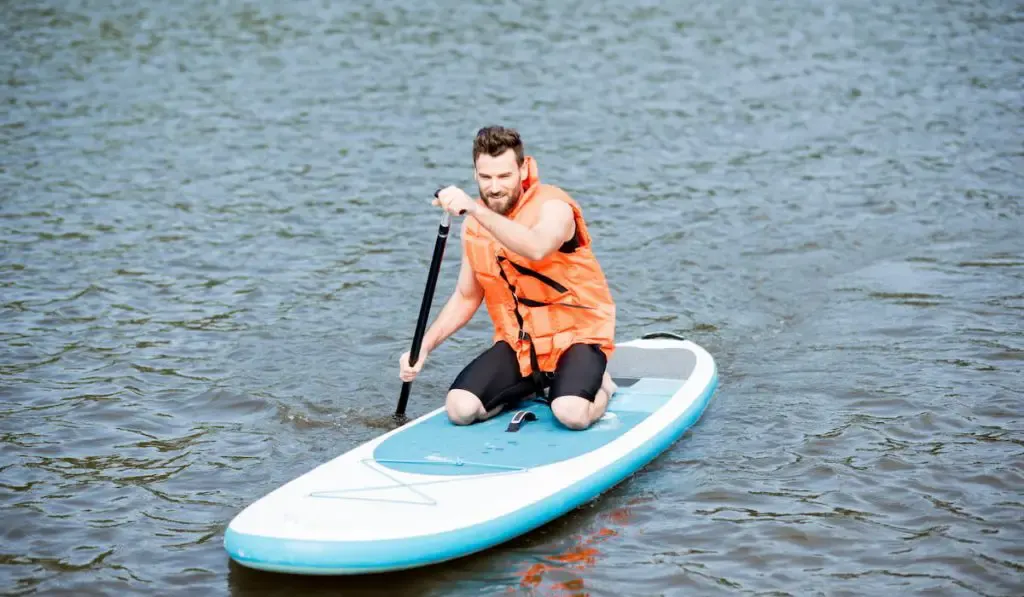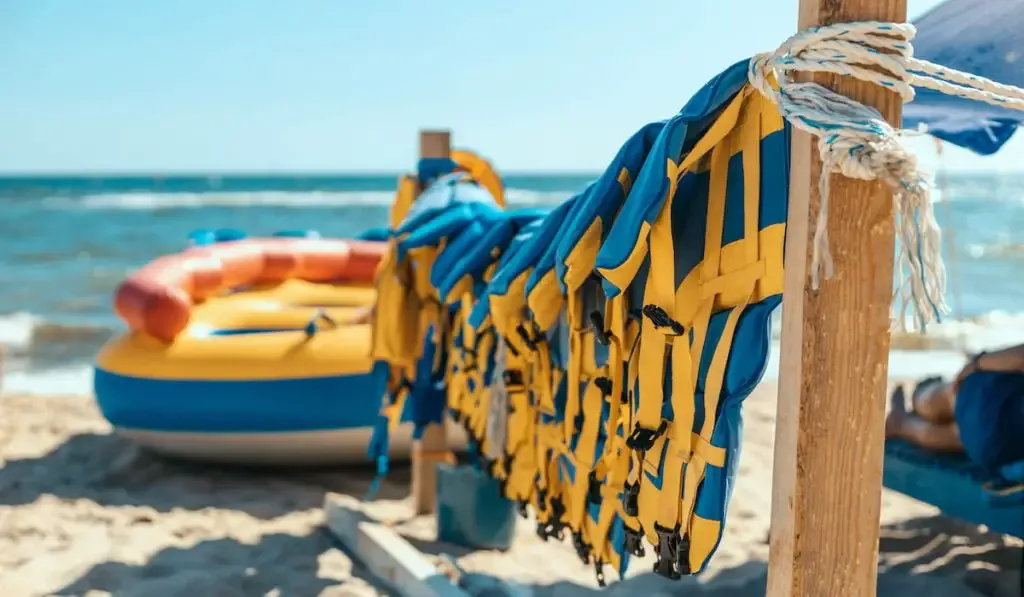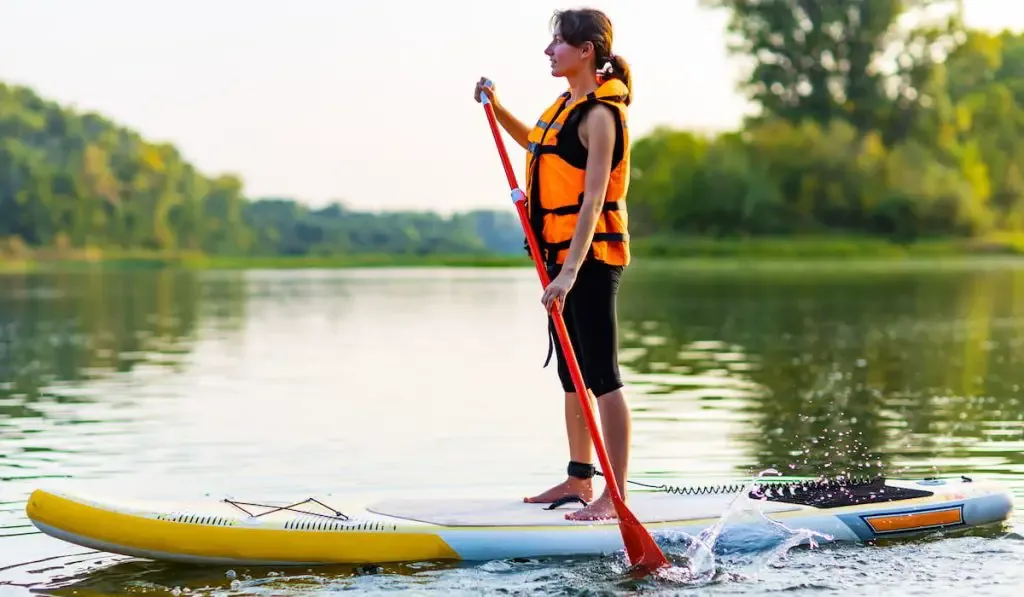Safety is a priority for any type of water sport. It doesn’t matter if you’re riding on a boat or parasailing, you should take precautions to limit your risk of injury or death.
Every year, too many people die unnecessarily because they were unsafe or went out on the water in unsafe conditions. Don’t let that be you.
People who are paddleboarding should always wear a lifejacket, even if you’re only practicing near the beach or shoreline of a lake. Getting used to wearing a life vest every time you go out will make you feel more comfortable wearing it and keep you safe.

Let’s explore some of the reasons why you should always wear a life vest on a paddleboard and how to choose a good vest for you.
Water Conditions Can Change Quickly
It’s hard to see what’s going on under the water. Even in what looks like a serene lake, the view on top of the water can be very different from what’s going on underneath the surface. In lakes, rivers, and the ocean, you’re dealing with undercurrents that can pull you under and hold you there.
If you’re out on the ocean with your paddleboard, you’re also dealing with waves and changing tides. Even strong swimmers can struggle to get past breaks, and when you’re trying to do it with a large paddleboard, you’ll be glad you’re wearing a vest.
What if you find yourself out on the ocean paddleboarding and a large swell comes in, bringing with it high waves and turbulent waters? You may not always have the right amount of time to react, and you could end up in the water.
Play it safe by wearing a life vest no matter where you’re paddleboarding.
Navigating Other Vehicles
Sometimes you can find quiet places with little traffic on the water. It’s a great way to get away from it all and spend some time relaxing in nature.
Paddleboarding is a great exercise, but it’s also a fantastic way to erase the stress from work or worries at home. It’s just you, your board, and the water.
Other times, though, there are a lot of other people trying to do the same thing you are. They’re out on boards, in kayaks and canoes, or driving boats and other motorized water vessels. There are no traffic lanes in the water, and sometimes it’s hard to predict how fast someone will come at you and which way they will turn.
Not only are water vehicles dangerous in and of themselves, but they also create waves and a wake that force a lot of paddleboarders off of their board. One moment you’re paddling peacefully, and the next you’re tossed in the water!
Having a vest on gives you peace of mind knowing you’re prepared for whatever comes your way. It will keep you higher up in the water so it’s easier for boats and other people to see you floating, and the colors make you easier to notice.

Life Jackets Keep You Warm
Ok, so this isn’t the main reason you should wear a life vest, but it’s a good one still! It’s easy to get cold out there on the water. Even gentle breezes make you feel like it’s chillier than it is.
Having a jacket on, in addition to something like a wetsuit, will help keep you warm when the temperature drops. It’s a good safety measure, but it’s also part of effective trip planning when you’re going out on the water for long periods or during colder weather.
They Help You Get Back on Your Board
If you’re new to the sport, or you’re not the strongest of swimmers, having a life vest on when you’re paddleboarding will be a great help for when you fall off and into the water.
It’s going to happen at some point. You can practice getting on and staying on in shallow water a million times, but odds are you’re going to fall in once you start going or hit your first few waves.
Falling off in water that you can stand in is one thing, but what about deep water where you can’t touch the bottom? How do you get back on?
A life vest makes it way easier to get back on your board and keep going. If you’re in the ocean and you see jellyfish or your board is headed in the wrong direction, getting on quickly is a priority. Your vest will buoy some of your weight so you can push yourself up and get back on faster.
They Will Save Your Life
Of course, having a life vest is most important because it could end up saving your life.
It doesn’t matter if it’s changing weather, strong currents, or a freak accident, life jackets save lives.
In some cases, people are thrown off of their boards and into the water with such force that they don’t know which way is up.
They start swimming deeper into the water thinking they are trying to get to the surface. Other times, people suffer concussions that knock them out and send them sinking to the bottom.
Even if you’re a strong swimmer and paddleboarding in an area you know well, wearing a life vest eliminates a lot of the risk during any water activity.
It’s Usually the Law
Finally, wearing a lifejacket while you’re paddleboarding is usually the law. In a ton of places, local governments stipulate that paddleboarders and other activities require a personal flotation device.
If you don’t wear one, you could face fines and other penalties.
Not exactly the way you want your weekend or day off from work to go. Rather than go through the local laws and codes to find out if a PFD is required, just wear one wherever you go to be on the safe side.

Choosing the Right Life Jacket for Paddleboarding
Now that you know you need a life vest for paddleboarding, you don’t want to just run to the store and buy any old PFD. You’re doing exercise, after all, and you will want something that provides a range of motion as well as security on the water.
Here are some things you should look for to buy a vest that fits well and gets the job done.
- Fit – Fit is always an important consideration. Too many people end up shrugging off their vests because they feel uncomfortable and make paddling feel restrained. It can be hard to get good strokes with a cumbersome vest on.
Having a vest that fits well and lets you perform the way you want will make it easier to keep wearing it. Find something that fits.
Buoyancy – Another thing that you have to consider is buoyancy. You’ve probably seen some vests that are thin and light, and others that make you look 50 pounds heavier than you are. Why the difference?
Sure, some of it is due to advances made in modern vests vs. older vests, but a lot of it has to do with buoyancy levels.
Here are some different types of PFDs to consider:
Type 1
This is typically an offshore life jacket that gives over 22 pounds of buoyancy. This is usually strong enough to flip someone over face-up after they’ve fallen in the water.
You’ll also stay afloat longer and higher up in the water with one of these vests on.
Type 2
These are smaller jackets with less buoyancy designed for shallower water in nearshore environments.
These aren’t designed to keep you floating forever, but rather just long enough for someone to come to administer aid when necessary.
Type 3
This is a light vest that has very little chance of flipping a face-down swimmer onto their backs.
They are ideal only for fast rescue situations where someone else can jump in the water in short order.
Type 4
Type 4 PFDs include things like ring buoys and boat cushions. They’re great at helping people stay afloat, but they’re not devices designed to be worn on the body for long periods.
Thus, they’re not great for paddleboarding.
Type 5
These vests have the highest buoyancy rating and are a good safeguard against drowning in most water environments.

The Right Vest for You
At the end of the day, you are going to have to find a vest that balances comfort, performance, and safety. Read reviews, try them on, and see how they feel in the water.
Where you paddleboard and how far you want to push yourself in the sport should also play a role in which type of vest you end up with.
Thankfully, modern vests are lighter and sleeker than in past generations. They actually look like performance gear, and more people enjoy wearing them because they don’t limit your motion or look out of place.
You can find them in fantastic colors, they’re simple to put on, and they fit into your car without any trouble. You can carry them along wherever you go and have peace of mind that you’re protected no matter what the conditions.
